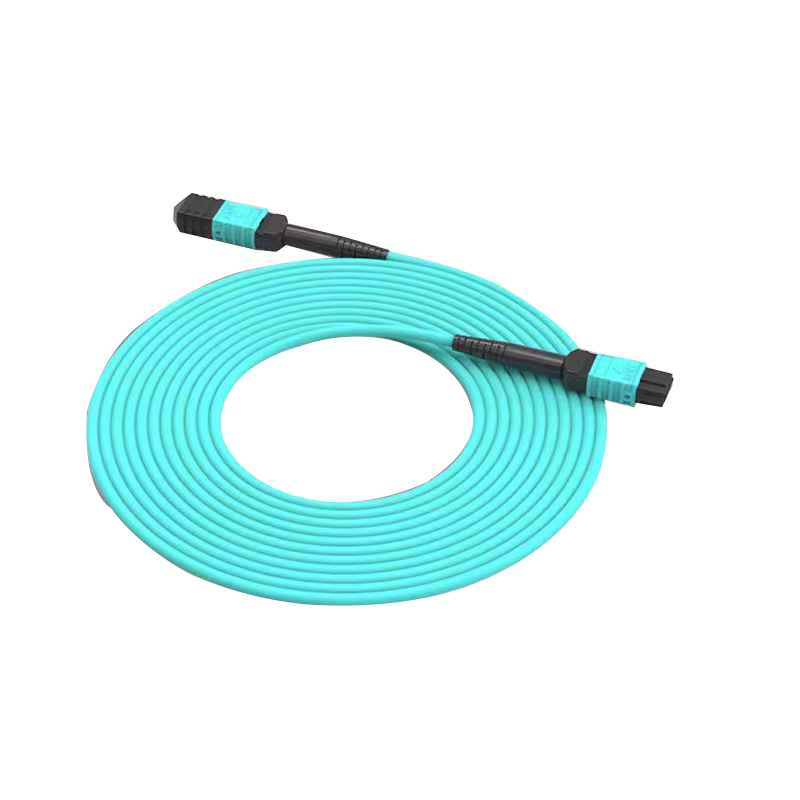Overview and Applications of Multi-Fiber MPO Optical Patch Cords
1. Introduction to MPO Optical Patch Cords
MPO (Multi-fiber Push On) optical patch cords are fiber optic cables equipped with multiple fibers, widely used in high-density data transmission and optical fiber networks. The MPO patch cord utilizes a modular design, typically featuring 12, 24, 48, or more fiber channels, allowing for the transmission of multiple optical fibers through a single connector. Due to their high density and efficiency, MPO patch cords are commonly used in modern data centers, local area networks (LANs), cloud computing centers, and other high-speed communication systems.
2. Features of MPO Optical Patch Cords
- Multi-fiber Design: One of the key features of MPO patch cords is their multi-fiber design. Unlike traditional single-fiber patch cords, MPO patch cords typically contain 12, 24, or even more fiber cores, allowing multiple fibers to be transmitted through a single connector. This design significantly increases the connection density and saves installation space.
- Modular Connector: The MPO connector itself is a modular structure, with each module containing multiple fiber channels. Common specifications for MPO patch cords are MPO-12 and MPO-24. By using this modular connection method, MPO patch cords can simultaneously connect multiple fibers in one slot, greatly improving system transmission efficiency.
- High Bandwidth Support: MPO patch cords support bandwidths up to 100G/400G, making them ideal for data-intensive applications such as large-scale data transmission, video streaming, and cloud services. This makes them the perfect choice for modern fiber networks and high-speed internet infrastructure.
- Compatibility with Various Ports: Although MPO is a multi-fiber connector, it can be adapted to various types of fiber ports such as LC, SC, and others. This compatibility gives MPO patch cords greater flexibility to meet different fiber device connection needs.
3. Applications of MPO Optical Patch Cords
- Data Centers: Due to their high-density connection advantages, MPO patch cords are widely used in data center cabling systems. In data centers, optical patch cords connect the fiber links between various devices. The high-density design of MPO patch cords enables more fiber channels in a limited space, greatly improving efficiency and capacity.
- Cloud Computing and High-Performance Computing: With the increasing demand for cloud computing and high-performance computing (HPC), MPO patch cords have become an essential component in these scenarios. They support massive data transmission in parallel, meeting the high-speed and high-bandwidth requirements of data processing and computing.
- 5G Networks: The construction of 5G networks places higher demands on communication infrastructure, and MPO patch cords can support the high-speed data transmission requirements of 5G networks. As 5G technology continues to evolve, the demand for MPO patch cords will continue to grow.
- High-Frequency Trading and Financial Industry: High-frequency trading and the financial industry have stringent requirements for network latency and bandwidth. The high-speed transmission capabilities of MPO patch cords make them an ideal optical solution for these industries.
4. Advantages of MPO Optical Patch Cords
- High-Density Connections: Since multiple fibers can be connected through a single connector, MPO patch cords provide more fiber channels in a limited space, saving space and improving network efficiency.
- Convenient Installation and Maintenance: MPO patch cords use standardized connectors, making installation and maintenance easy. Compared to traditional optical patch cords, MPO patch cords can quickly achieve large-scale fiber connections, greatly simplifying cabling complexity.
- Adaptability to High-Speed Networks: The high-bandwidth characteristics of MPO patch cords make them suitable for the development of future network technologies. They support 10G, 40G, 100G, and even 400G high-speed transmission, meeting the demands of big data and high-speed internet.
- Modular and Scalable: The modular design of MPO patch cords ensures good scalability. When expanding network capacity in the future, new fiber connections can be quickly added, ensuring flexibility and scalability for fiber connections.
5. How to Choose the Right MPO Optical Patch Cord
When selecting an MPO optical patch cord, the following factors should be considered:
- Fiber Type: Choose between single-mode or multi-mode fiber depending on the application. Single-mode fiber is suitable for long-distance transmission, while multi-mode fiber is used for short-distance transmission.
- Core Count: Choose the appropriate fiber core count based on the device and network structure requirements. Common options include 12-core, 24-core, and 48-core, ensuring compatibility with the connector and device.
- Connector Type: MPO optical patch cords can be adapted to various types of fiber ports such as LC, SC, and others. Make sure the connector type matches the optical fiber ports of your devices.
- Cable Length: Choose the appropriate patch cord length to match the device layout, avoiding excessively long or short cables that could make cabling difficult.
6. Conclusion
MPO optical patch cords, with their high density, high bandwidth, and efficient transmission capabilities, have become a critical component in modern fiber optic networks. Whether in data center construction, cloud computing, 5G communication, or in high-performance computing and financial industries, MPO optical patch cords play a vital role. As technology continues to advance, MPO optical patch cords will remain crucial for future communication and data transmission systems.

Comments are closed